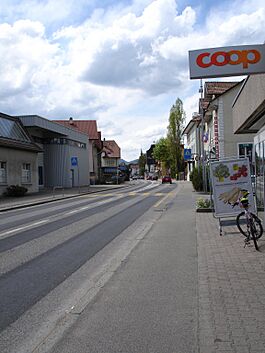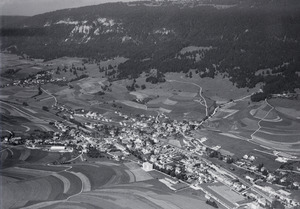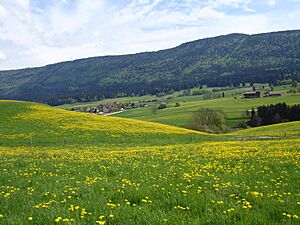Malleray facts for kids
Quick facts for kids
Malleray
|
||
|---|---|---|

Malleray village
|
||
|
||
| Country | Switzerland | |
| Canton | Bern | |
| District | Jura bernois | |
| Area | ||
| • Total | 10.35 km2 (4.00 sq mi) | |
| Elevation | 699 m (2,293 ft) | |
| Population
(Dec 2011)
|
||
| • Total | 1,970 | |
| • Density | 190.3/km2 (493.0/sq mi) | |
| Postal code |
2735
|
|
| Surrounded by | Reconvilier, Loveresse, Pontenet, Souboz, Champoz, Bévilard, Péry | |
| Twin towns | Tar (Hungary) | |
Malleray was a town, also called a municipality, in Switzerland. It was part of the Jura bernois district in the canton of Bern. Malleray is in the French-speaking part of Switzerland known as the Bernese Jura. On January 1, 2015, Malleray joined with two other towns, Bévilard and Pontenet. They all became part of a new, larger municipality called Valbirse.
Contents
History of Malleray
Malleray was first mentioned in old writings in 1179. Back then, it was called Malareia. It also had a German name, Mallaraya, but this name is not used anymore.
We don't know much about the very early days of the village. In 1367, a leader called the Prince-Bishop of Basel tried to make the city of Biel break a special agreement. This agreement was called a burgrecht treaty, and it was with the city of Bern. But at Malleray, the Prince-Bishop's soldiers were defeated by an army from Solothurn. This army was on its way to help Bern.
A noble family, the de Mallerays, lived in the area during the 1300s and 1400s. They might have been related to the Tavannes family. Over many years, the leader of the Moutier-Grandval Abbey slowly gained control of most of the land and rights in Malleray.
Later, in the late 1500s, the Abbey's power ended. Malleray then became part of a region managed by the diocese of Basel. After France won a war in 1797, Malleray became part of France. It was first in the French area called Mont-Terrible, then later in Haut-Rhin. After Napoleon was defeated, Malleray became part of the Canton of Bern in 1815.
In 1846, the watchmaking industry started in Malleray. This changed the village from a farming community into an industrial town. The building of the Tavannes-Moutier railroad from 1874 to 1877 sped up this change. Many new people moved to Malleray for jobs in watch factories. Even today, about half of all jobs in Malleray are in industries that make precise things.
Geography and Landscape
Before it merged, Malleray covered about 10.2 square kilometers (about 4 square miles). In 2012, nearly half of this land (47.6%) was used for farming. About 42.6% of the land was covered by forests.
The rest of the land was used for buildings and roads (9.1%). A very small part (0.2%) was rivers or lakes. Most of the forested land was dense forest. Some areas had orchards or small groups of trees. For farming, some land was used for crops, some for pastures, and some for alpine pastures. All the water in Malleray was from flowing rivers.
Malleray is located in the Vallée de Tavannes, which means the Tavannes Valley. It sits along the banks of the Birs River.
The old district that Malleray belonged to, called District de Moutier, was closed down on December 31, 2009. The next day, January 1, 2010, Malleray joined the new administrative district called Arrondissement administratif Jura bernois.
Coat of Arms
The coat of arms for Malleray is a blue shield. On it, there is a proud golden rooster crowing. It has a red comb and wattle. The rooster stands on three silver hills. In the top left corner, there is a silver five-pointed star.
People and Population
In 2013, Malleray had a population of 1,972 people. In 2010, about 18.8% of the people living there were foreign nationals. This means they were not citizens of Switzerland. Over ten years (from 2001 to 2011), the population changed only a little.
Most people in Malleray (88.1%) speak French as their main language. German is the second most common language (4.4%), and Italian is third (3.1%). Only one person spoke Romansh.
In 2008, about 48.8% of the population was male and 51.2% was female. Most people were Swiss citizens. About 32.7% of the people living in Malleray in 2000 were also born there. Many others were born in the same canton or elsewhere in Switzerland. About 16.1% were born outside Switzerland.
In 2011, children and teenagers (0–19 years old) made up 21.8% of the population. Adults (20–64 years old) were 57.6%, and seniors (over 64 years old) were 20.7%.
In 2000, there were 730 single people in Malleray who had never been married. There were 934 married people, 112 widows or widowers, and 78 divorced people.
In 2010, there were 235 households with only one person. There were 55 households with five or more people. In 2000, most apartments (83.4%) were lived in all the time. Some were used only at certain times of the year, and some were empty. In 2011, single family homes made up 58.3% of all homes in Malleray.
The chart below shows how Malleray's population has changed over time:

Economy and Jobs
In 2011, Malleray had an unemployment rate of 2.49%. This means a small number of people who wanted jobs could not find them. In 2008, there were 920 people working in the town.
Jobs are often grouped into three main types:
- Primary sector: These jobs involve getting raw materials from nature. In Malleray, 30 people worked in this sector, mostly in farming.
- Secondary sector: These jobs involve making things. In Malleray, 513 people worked in this sector. Most of them (83.6%) were in manufacturing, like making watches. Others (16.1%) worked in construction.
- Tertiary sector: These jobs involve providing services. In Malleray, 377 people worked in this sector. This included jobs in sales, transportation, hotels, restaurants, and healthcare. Many also worked in education.
In 2000, 365 workers came into Malleray for their jobs. However, 557 workers left Malleray to work in other towns. This means more people left Malleray for work than came in. About 378 workers lived and worked in Malleray.
For getting to work, 9.6% of workers used public transportation. Most workers (57.3%) used a private car.
In 2011, the average tax rate for a married person with two children in Malleray was 13.6%. For an unmarried person, it was 20%. These rates were similar to the rest of the canton of Bern.
Religion
Based on a survey from 2000, about 48.1% of the people in Malleray belonged to the Swiss Reformed Church. About 31.7% were Roman Catholic.
A smaller number of people belonged to other Christian churches. There were also a few people who were Islamic or Buddhist. About 7.17% of the population said they did not belong to any church.
Education
In Malleray, about 52.6% of adults have finished high school, which is called "upper secondary education." About 10.1% have gone on to higher education, like university or a special college called a Fachhochschule.
The school system in the Canton of Bern works like this:
- One year of optional Kindergarten.
- Six years of Primary school.
- Three years of mandatory lower Secondary school. In this school, students are grouped by their abilities.
After lower Secondary school, students can continue their education or start an apprenticeship. An apprenticeship is when you learn a job by working with an experienced person.
During the 2011–12 school year, 386 students went to school in Malleray. There were 54 kindergarten students, 133 primary students, and 199 lower secondary students. Some of these students were not Swiss citizens, and some spoke a different language at home than in the classroom.
In 2000, 256 students lived and went to school in Malleray. Another 161 students came from other towns to go to school in Malleray. At the same time, 49 students from Malleray went to schools outside the town.
See also
 In Spanish: Malleray para niños
In Spanish: Malleray para niños






